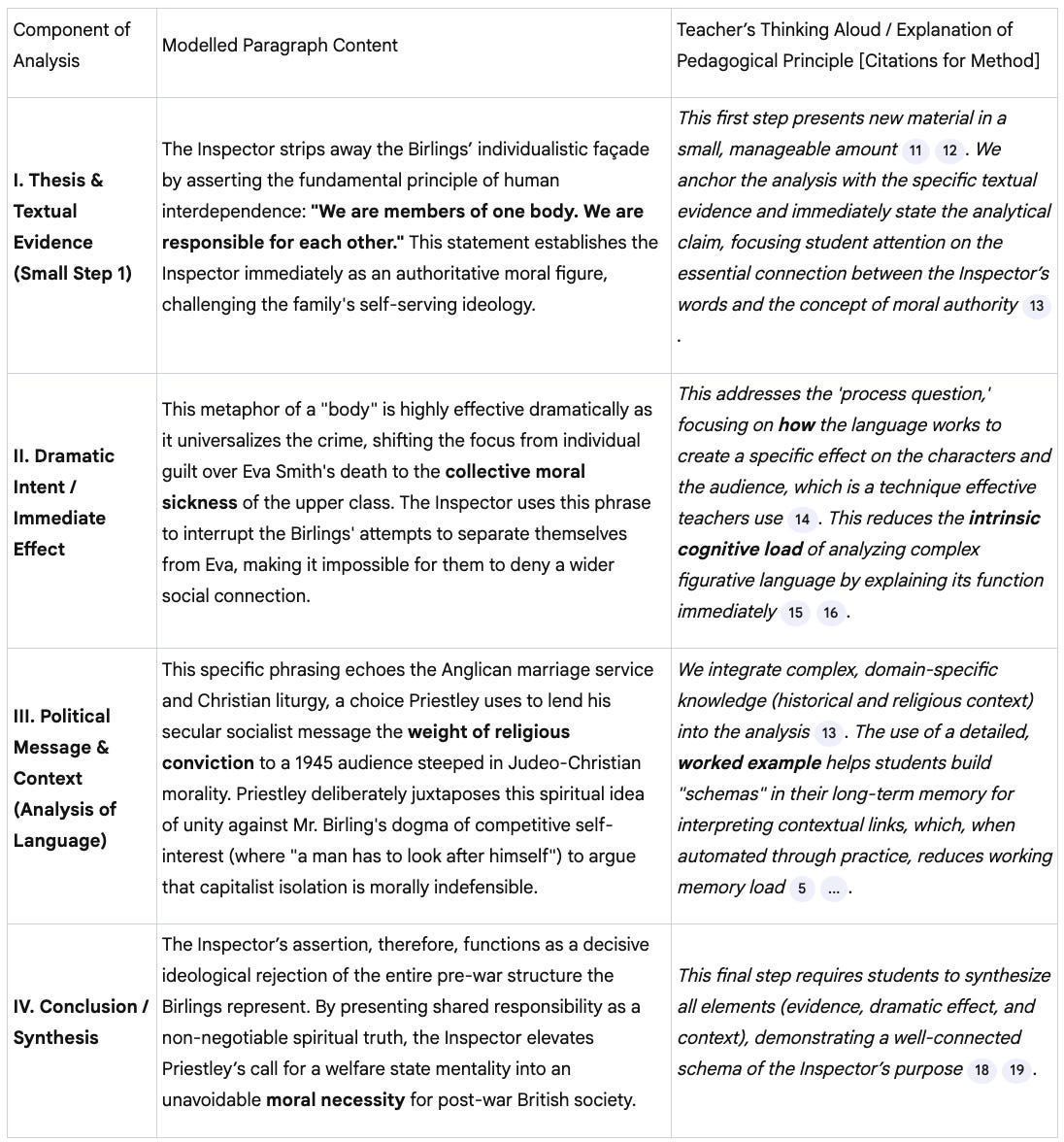How to Teach (with AI)
AI hallucinates. It’s cheating. It stops teachers thinking for themselves. It’s never going to be as good as my professional expertise.
All these statements might be true.
But I’d like to show you a different truth, too.
NotebookLM is an AI which will only use the sources which you trust. You can upload up to 50 such sources - PDFs, webpages, YouTube videos. And your word limit is an astonishing 25 million words.
I uploaded 4 sources:
Rosenshine’s Principles of Instruction
What Makes Great Teaching (Robert Coe)
Cognitive Load Theory (New South Wales department of education)
Top 20 Principles of Psychology (American Psychological Association, Coalition for Psychology in Schools and Education. (2015). Top 20 principles from psychology for preK–12 teaching and learning)
This would mean whatever activities it generated for my students would be high value, with a direct impact on learning.
I didn’t upload my resources on An Inspector Calls - it is the activities for learning I wanted to test with NotebookLM.
My Prompt
I want to teach An Inspector Calls. Use these sources to create a series of lessons on the Inspector, dealing with Priestley’s purpose, the development of his character, the reason the Inspector leaves the play and the interpretation of his most important quotes. Include the activities students should carry out and provide an overview of what they should produce in each, with success criteria.
This link might work, if you want to access the Notebook I created. Gmail emails me your request and I grant you access.
Lesson Sequence
Series of Lessons on the Inspector in An Inspector Calls
The lesson structure adheres to principles like beginning with a review of previous learning, presenting new material in small steps with practice after each step, providing models, and guiding practice.
This was lesson 3 in a sequence of 3 (as an example)
Lesson 3: Interpretation of Most Important Quotes
This lesson moves to advanced analytical interpretation and prepares students for independent synthesis and extended writing using the Inspector’s most powerful lines.
(Those numbers? In Notebook these are clickable and take you straight to the part of your trusted source they reference. I’ve been using NotebookLM for 1 year and have only ever found 1 mistake).
Could I get the Worked Examples?
This worked example models how a student should structure a detailed paragraph that integrates textual evidence, dramatic intent, and Priestley’s political message regarding the Inspector’s final, pivotal speech.
The expert model uses an annotated format to illustrate the “thinking aloud” process that the teacher should follow, explaining the underlying principles of literary analysis and context.
Task Focus: Analyse how the Inspector’s final warning achieves Priestley’s social and political purpose.
Worked Example (Expert Model for Display)
(This language is a bit academic for most classrooms - this is where your professional judgement comes in. You can also ask for a rewording with the reading age you are after. I haven’t - I want you to see the quality in can produce from sources you trust).
--------------------------------------------------------------------------------
Student Activity: Applying the Model (Scaffolding and Guided Practice)
The sources note that effective instruction involves using scaffolds and partially completed problems during guided practice so students pay attention to the worked example and complete the missing steps.
The students should be given a different crucial Inspector quote and asked to complete a partially completed analytical paragraph, ensuring they follow the exact structure of the model provided above.
Example Quote: “Public men, Mr Birling, have responsibilities as well as privileges.”
Expert Worked Example 2: Analysing Collective Responsibility
This example models a detailed, complex analysis (an expert model) focusing on a core theme: the Inspector’s message of communal unity and social responsibility.
Quote Focus: “We are members of one body. We are responsible for each other.”
Student Activity: Partially Completed Problem (Scaffolding)
To move students toward independent practice, you would provide a similar quote and ask them to complete the missing, critical analytical steps. This approach, involving scaffolds and partially completed problems, is a recommended strategy to reduce the extraneous cognitive load that comes from trying to generate an entire complex answer from scratch.
What Next?
Whatever topic, or indeed subject you teach, uploading these 4 sources to NotebookLM will give you dozens of high quality ideas for you to steal and adapt.
You can also upload your existing scheme of work and ask NotebookLM to suggest better activities with your existing lesson plans.
The two models I have given you are at least 50% of an essay on the Inspector - it doesn’t just write the essay for you, it breaks down how to teach it to students so that they can construct it for themselves.
This post has only scratched the surface of what NotebookLM can do. Go and play with it - it will astound you.








Really interesting and helpful - thank you Dominic. The link does work, but readers need to ask for permission to access NotebookLM. I’ve not used it yet, so it will be great to have a play 😊.
This might seem like a very silly question, but did you upload a copy of An Inspector Calls? Or allow it to access wider commentary on the text, etc?